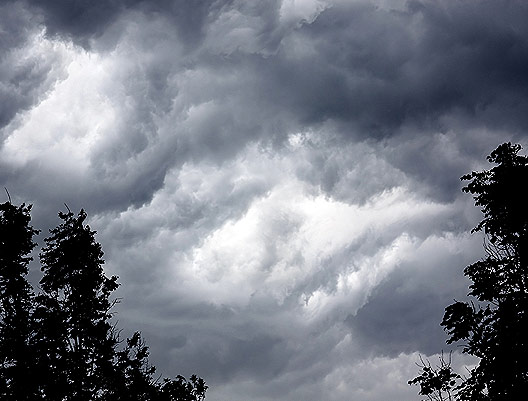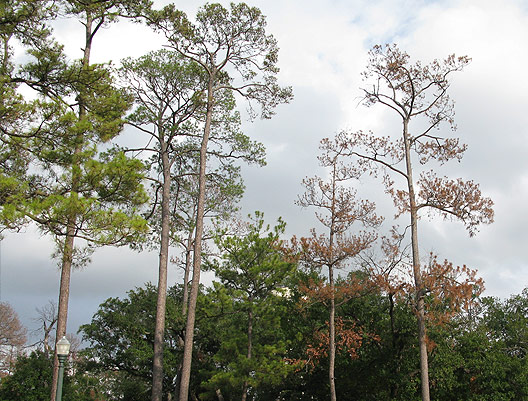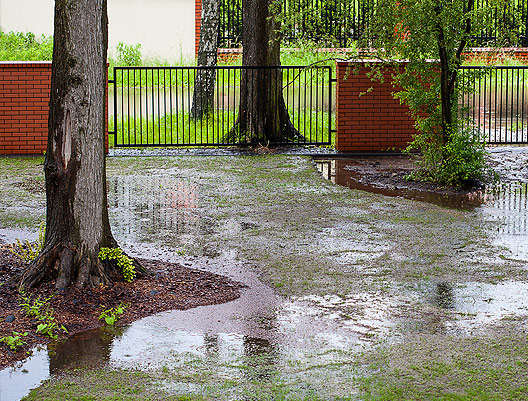what steps to take when shrubs are damged from a storm
Extreme weather events happen in nearly every geography, leaving a lasting impact on the trees and shrubs in a landscape. Once the rain or current of air has stopped, the snow has melted or the drought has passed, it takes time for plants to recover. During this fourth dimension, trees are under a tremendous amount of stress.
Aesthetically, depending on the situation, foliage may become discolored or wilted and branch dieback can occur. Trees may incur damage to the branches or crown. More seriously, structural damage – sometimes visible (a hanging co-operative or crack) and sometimes not (root impairment) – is commonplace. Stress from weather conditions also increases the likelihood of infestation from harmful insects and illness.
In a managed landscape, it'due south important to monitor trees closely after astringent weather. An inspection following the weather outcome will uncover firsthand damage, only some symptoms may not appear for months, or even years.
Learn how the conditions your surface area experiences can bear upon your trees and shrubs and how you can aid in the recovery process:
- Recovery from Storms
- Recovery from Drought
- Recovery from Flooding
Storm Damage

An approaching tempest threatens copse.
When major impairment occurs after a storm, immediate action is often required. Pruning or removal of copse that pose a chance to people or holding is prioritized in the days and weeks following a storm. Though landscapes seemingly "return to normal," lingering defects ofttimes impact the appearance and structural integrity of copse and shrubs.
Damaged wood, cracks, and exposed woods resulting from injuries like loss of branches serve as an entry point for insects and disease. The larger the wound is in relation to the size of the limb, the less probable it is to heal, posing greater risk. However, fifty-fifty small broken limbs increase the probability of secondary invaders.
Crown loss, when branches are broken off, severely bent or lost from the tree, is another serious concern. Typically, if more than 50% of the elevation of a tree is destroyed during a storm, mortality volition occur inside a few years. Copse with less crown damage have a practiced chance at recovery, merely the aesthetic impact may still be severe. The tree may look unbalanced or misshapen, which tin can exist particularly noticeable in a well-maintained mural.
Helping Trees Recover from Storms
- Prune hanging branches, damaged or expressionless wood
- Schedule crown restoration to reestablish desirable form and strong construction over fourth dimension; avoid over-pruning immediately after a storm every bit this can cause further injury
- Inspect for root damage, especially on leaning trees or those where the root flare is not visible
- Monitor for signs of pests and affliction
Drought

Trees showing signs of stress every bit a event of drought.
Water plays a significant role in numerous plant processes, including photosynthesis. Lack of water impacts a plant'south ability to manufacture food, which weakens the tree and limits future growth.
When soils remain dry, fine feeder roots in the upper soil surface are also adversely impacted. These roots, essential for transporting h2o and nutrients, begin to die. The root system is unable to support foliage and dieback occurs. Fifty-fifty when rain returns, the tree can't take full advantage due to loss of roots.
Drought-stressed trees have difficulty wounds, making them an piece of cake target for illness and opportunistic insects.
Helping Copse Recover from Drought
- Irrigate trees and shrubs deeply equally soon equally possible during summer and autumn
- Conserve moisture and improve the root environment by applying a layer of organic mulch around plantings
- in autumn or spring post-obit drought, merely but once soils are recharged by rainfall; provides little do good when h2o is the limiting growth factor
- Better your tree'due south ability to tolerate drought stress with the application of potassium phosphite
- Monitor for pest infestations, particularly borers, bawl beetles, root rot and stalk canker diseases
Flooding

Flooding of root systems tin negatively impact trees.
Even once the surface reappears after flooding, soil can stay waterlogged for long periods of time. An glut of water in the soil reduces the supply of oxygen to tree roots. Sediment deposited from flooding further exasperates the issue, creating a challenging growing surroundings for roots. Diseases like phytophthroa root rot and armillaria thrive in wet conditions and hasten the decline of stressed copse.
Flooding tin also impact the acerbity or alkalinity of the soil. Some species tolerate variance in pH, but others may struggle to survive when the soil limerick is altered.
While concrete injury may occur during flooding, the main concern is damage to the roots and dieback of the root system. When the root system is damaged, the tree as a whole will endure proportionately. Structural stability will also be since roots serve as an "anchor" to continue the tree upright.
Helping Trees Recover from Flood Damage
- Improve drainage and salvage compacted soil using air spade technology
- Perform soil analysis to make up one's mind pH and soil weather; apply based on results
- In one case flooding has subsided, apply a thin layer of organic mulch from simply off the trunk to the outer dripline
- Utilize potassium phosphite to improve affliction resistance
Source: https://www.bartlett.com/blog/2016/12/tree-advice/helping-trees-and-shrubs-recover-from-extreme-weather
0 Response to "what steps to take when shrubs are damged from a storm"
Post a Comment